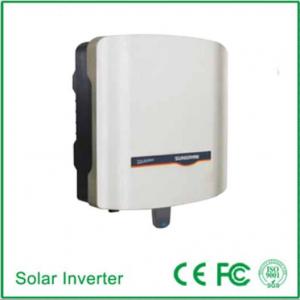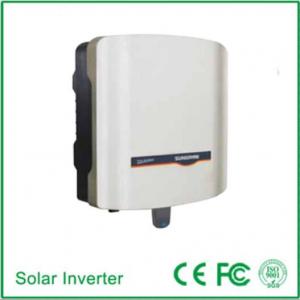Photovoltaic Grid-Connected Inverter SG4KTL-S
- Loading Port:
- China Main Port
- Payment Terms:
- TT or LC
- Min Order Qty:
- 50000 unit
- Supply Capability:
- 3000000 unit/month
OKorder Service Pledge
OKorder Financial Service
You Might Also Like
1. Structure of Photovoltaic Grid-Connected Inverter SG4KTL-S Description
A solar inverter, or PV inverter, or Solar converter, converts the variable direct current (DC) output of a photovoltaic (PV) solar panel into
autility frequency alternating current (AC) that can be fed into a commercial electrical grid or used by a local, off-grid electrical network.
It is acritical BOS–component in a photovoltaic system, allowing the use of ordinary AC-powered equipment. Solar inverters have
special functions adapted for use with photovoltaic arrays, including maximum power point tracking and anti-islanding protection.
Suitable for 50Hz/60Hz grid, could be used in Asia, Africa and Europe. Available for hand installation, no need for lifting machinery
assistance.
2. Main Features of the Photovoltaic Grid-Connected Inverter SG4KTL-S
• Max. input voltage 600V, compatible with different PV panel and string design
• Only 9kg, easy for handling and installation
• Max. Efficiency at 98.0%
• Ultra-quiet, suitable for residential use
• Access to home WiFi system, easy to enjoy the online monitoring
• Wireless communication design, intelligent mobile phone local and remote monitoring
• Product certification: TÜV, CE, AS4777, AS/NZS 3100, VDE AR N 4105
• Manufacturer certification: ISO 9001, ISO 14001, OHSAS 18000
3. Photovoltaic Grid-Connected Inverter SG4KTL-S Images


4. Photovoltaic Grid-Connected Inverter SG4KTL-S Specification
Input Side Data | |
| Max. PV input power | 4300W |
| Max. PV input voltage | 600V |
| Startup voltage | 150V |
| Nominal input voltage | 345V |
| MPP voltage range | 125~560V |
| MPP voltage range for nominal power | 240~520V |
| No. of MPPTs | 1 |
| Max. number of PV strings per MPPT | 2 |
| Max. PV input current | 18A |
| Max. current for input connector | 20A |
| Output Side Data | |
| Nominal AC output power | 4000W |
| Max AC output power(PF=1) | 4210W |
| Max. AC output apparent power | 4210VA |
| Max. AC output current | 18.3A |
| Nominal AC voltage | 230Vac (Single phase) |
| AC voltage range | 180~276Vac (May vary as per corresponding country’s grid standard) |
| Nominal grid frequency | 50Hz/60Hz |
| Grid frequency range | 45~55Hz/55~65Hz (May vary as per corresponding country’s grid standard) |
| THD | < 3 % (Nominal power) |
| DC current injection | <0.5 %In |
| Power factor | >0.99@default value at nominal power, (adj. 0.8 overexited~0.8 underexcited) |
| Protection | |
| Anti-islanding protection | YES |
| LVRT | NO |
| DC reverse connection protection | YES |
| AC short circuit protection | YES |
| Leakage current protection | YES |
| DC switch | Optional |
| DC fuse | NO |
| Overvoltage protection | Varistors |
| System Data | |
| Max. efficiency | 98.00% |
| Max. European efficiency | 97.50% |
| Isolation method | Transformerless |
| Ingress protection rating | IP65 |
| Night power consumption | <1W |
| Operating ambient temperature range | -25~60℃ (>45℃ derating) |
| Allowable relative humidity range | 0~100% |
| Cooling method | Natural cooling |
| Max. operating altitude | 4000m (>2000m derating) |
| Display | LED, LCD(optional) |
| Communication | WiFi (optional) |
| DC connection type | MC4 |
| AC connection type | Plug and play connector |
| Certification | IEC61000-6-2,IEC61000-6-3, |
| AS/NZS3100,AS4777.2,AS4777.3 | |
| VDE-AR-N-4105, VDE0126-1-1,CE,G83/2,C10/11,EN50438,CGC | |
| Mechanical Data | |
| Dimensions(W×H×D) | 300*370*125 mm |
| Mounting method | Wall bracket |
| Weight | 9kg |
5. FAQ of Photovoltaic Grid-Connected Inverter SG4KTL-S
Q1:Which payment terms can you accept?
A1:T/T,L/C,Moneygram,Paypal are available for us.
Q2:Can we visit your factory?
A2:Sure,welcome at any time,seeing is believing.
- Q:What is the role of voltage support in a solar inverter?
- The role of voltage support in a solar inverter is to maintain a stable and appropriate voltage level for the solar system. It ensures that the generated solar power is compatible with the electrical grid and devices connected to it, preventing any damage or malfunction. Additionally, voltage support helps optimize the efficiency and performance of the solar inverter, maximizing the power output from the solar panels.
- Q:What is the standby power consumption of a solar inverter?
- The standby power consumption of a solar inverter refers to the amount of power that the inverter consumes when it is in standby mode or not actively converting solar energy into usable electricity. This power consumption is generally very low, typically ranging from 1 to 5 watts, as the inverter only needs to maintain its internal circuitry and monitor the solar energy availability.
- Q:Can a solar inverter work in low light conditions?
- Yes, a solar inverter can work in low light conditions. While the output power of a solar inverter may decrease in low light conditions, it is still capable of converting the available sunlight into usable electricity. The performance may vary depending on the specific model and technology used, but modern solar inverters are designed to work efficiently even in low light situations.
- Q:Can a solar inverter be used in systems with multiple solar arrays?
- Yes, a solar inverter can be used in systems with multiple solar arrays. A solar inverter is designed to convert the direct current (DC) produced by solar panels into usable alternating current (AC) for powering electrical devices or feeding back into the grid. It can be connected to multiple solar arrays in parallel or series to increase the overall power output of the system. However, it is important to ensure that the inverter is properly sized and matched to the combined capacity of all the solar arrays to ensure optimal performance and efficiency.
- Q:What is the difference between a grid-connected inverter and an off-grid inverter? What are the advantages of a hybrid inverter?
- Off-grid inverter is equivalent to their own to establish an independent small power grid, mainly to control their own voltage, is a voltage source.
- Q:Can a solar inverter be used with a remote control system?
- Yes, a solar inverter can be used with a remote control system. Many modern solar inverters come equipped with built-in communication interfaces that allow for remote monitoring, control, and adjustment of the inverter's settings. This can be done through a dedicated software or mobile application, allowing users to conveniently manage their solar energy system from a remote location.
- Q:Can a solar inverter be connected to a home automation system?
- Yes, a solar inverter can be connected to a home automation system. By integrating the solar inverter with the home automation system, homeowners can monitor and control their solar power production, track energy usage, and automate various energy-saving functions such as adjusting thermostat settings, turning off appliances, or scheduling energy-intensive tasks during peak solar production hours. This integration enhances the overall efficiency and convenience of managing solar energy within a smart home environment.
- Q:Can a solar inverter be used in conjunction with a power factor correction device?
- Yes, a solar inverter can be used in conjunction with a power factor correction device. The power factor correction device helps to improve the power factor of the electrical system, ensuring efficient and reliable operation. By installing a power factor correction device in combination with a solar inverter, the overall power quality can be enhanced, leading to optimized energy utilization and reduced electricity costs.
- Q:Can a solar inverter be used in a commercial solar system?
- Yes, a solar inverter can definitely be used in a commercial solar system. In fact, solar inverters are an essential component in converting the direct current (DC) electricity generated by solar panels into alternating current (AC) electricity that is compatible with the electrical grid and can be used by commercial buildings and businesses.
- Q:What is the maximum AC power output of a solar inverter?
- The maximum AC power output of a solar inverter varies depending on the specific model and capacity. It can range from a few hundred watts for small residential inverters to several megawatts for large commercial or utility-scale inverters.
1. Manufacturer Overview |
|
|---|---|
| Location | |
| Year Established | |
| Annual Output Value | |
| Main Markets | |
| Company Certifications | |
2. Manufacturer Certificates |
|
|---|---|
| a) Certification Name | |
| Range | |
| Reference | |
| Validity Period | |
3. Manufacturer Capability |
|
|---|---|
| a)Trade Capacity | |
| Nearest Port | |
| Export Percentage | |
| No.of Employees in Trade Department | |
| Language Spoken: | |
| b)Factory Information | |
| Factory Size: | |
| No. of Production Lines | |
| Contract Manufacturing | |
| Product Price Range | |
Send your message to us
Photovoltaic Grid-Connected Inverter SG4KTL-S
- Loading Port:
- China Main Port
- Payment Terms:
- TT or LC
- Min Order Qty:
- 50000 unit
- Supply Capability:
- 3000000 unit/month
OKorder Service Pledge
OKorder Financial Service
Similar products
New products
Hot products
Related keywords































